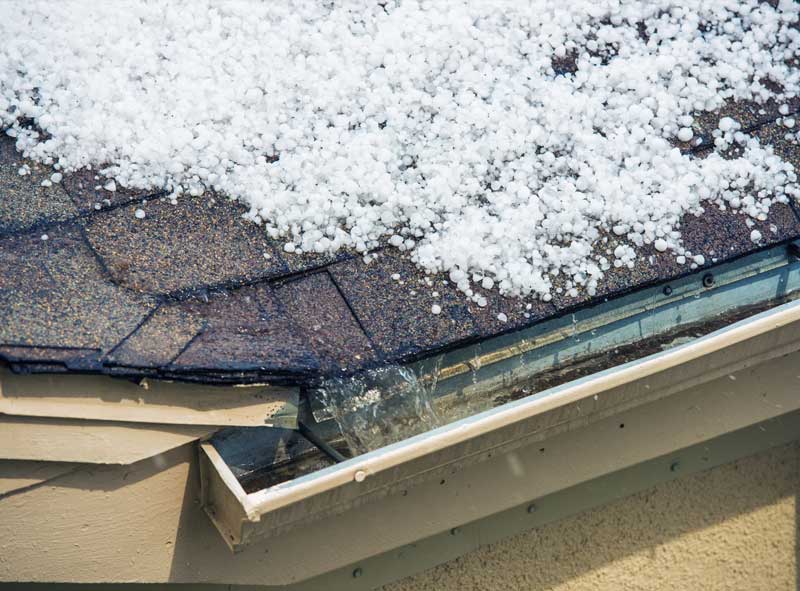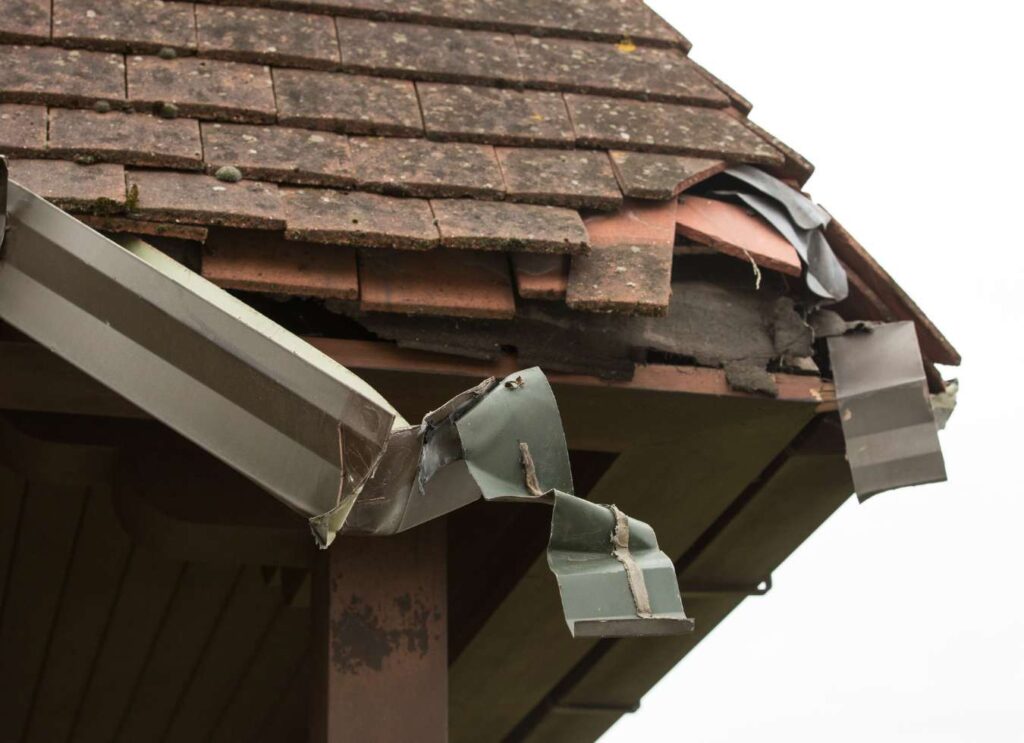Alright, folks, let’s take a moment to discuss something that might not always be on your mind but should be on your radar: gutters and downspouts.
Yes, I know. You’re probably thinking, “Gutters? Really? That’s not as exciting as a new kitchen remodel or a shiny new car, right?” But trust me, when it comes to protecting your home from water damage, gutters are the unsung heroes of your roofing system.
Now, I’m guessing you’re here because you’ve recently experienced one of Colorado’s infamous hailstorms (don’t worry, you’re not alone—we’ve all been there), and now you’re dealing with the aftermath.
Whether your gutters are bent, dented, or simply not functioning as they should, it’s time to chat about why getting new gutters and downspouts after a hailstorm can save you from a whole heap of future issues, like leaks that could cost you big time.
So, sit tight, maybe grab a cup of coffee (or a glass of wine; we won’t judge), and let’s discuss the importance of a roof inspection. Ready to prevent leaks? Let’s ensure your roof is inspected for any potential issues!

Why Are Gutters So Important After a Hailstorm?
If you’ve lived in Colorado for over a few months, you know one thing: Hailstorms are a thing. One minute, it’s a sunny day, and the next, you’re being pelted with hailstones ranging from pea-sized to golf balls (or even softballs), which can cause significant roof damage. That’s a lot of force on your roof—and, more importantly, your gutters.
After a hailstorm, many homeowners are focused on checking their roofs for damage, which is necessary. But your gutters deserve some love, too. Here’s why:
1. Hail Can Cause Immediate Damage to Gutters
When hail comes down, it doesn’t just cause a little “dimple” in your gutters. Depending on the size and intensity of the storm, hail can bend, dent, or even break your gutters and downspouts. This damage creates many issues, but the biggest is water flow disruption.
Dented, bent, or cracked gutters won’t be able to do their job correctly: directing water away from your roof and foundation. When your gutters fail to do their job, you end up with standing water, leaks, and possible damage to your home’s foundation—things you don’t want on your list of worries.
2. Clogged Gutters Are Even Worse After Hail
Aside from physical damage, hail can lead to debris buildup in your gutters. Small branches, leaves, and bits of roof material that get dislodged during the storm can accumulate in your gutters and cause blockages. A clogged gutter is a disaster waiting to happen: overflowing water can lead to flooding, serious roof leaks, rotting fascia boards, and, eventually, leaks inside your home.
A simple clogged gutter might seem like a minor problem, but it can significantly damage your home’s exterior and interior.
So, what’s the solution? Replace those damaged gutters!

How New Gutters and Downspouts Help Prevent Leaks Post-Hailstorm
Now that we’ve established how hailstorms can wreak havoc on your gutters, let’s talk about why replacing those gutters after a storm is so important.
1. Proper Water Management
Your gutters are designed to direct rainwater (and snowmelt) away from your roof and foundation. When gutters get damaged, they can no longer do that effectively. The result? Water overflows and pools in places where it shouldn’t. This leads to leaks in your home, the last thing you want after a storm.
New gutters can redirect water how they were meant to—away from your home—keeping your roof, foundation, and basement safe from water intrusion. This is especially critical in Colorado, where we can go from snow to rain and back again in the blink of an eye, potentially leading to storm damage. When your gutters are working correctly, you don’t have to worry about flooding, which can result in extensive structural damage to your home, or water damage, causing significant headaches.
2. Improved Drainage with New Downspouts
When your downspouts are damaged or clogged, water can easily pool around your foundation, causing foundation damage (which nobody has the time or money to deal with). Installing new downspouts and gutters ensures that water is directed well away from your home’s base, preventing that dreaded foundation problem.
But there’s more to consider when dealing with storm damage! New downspouts help:
- Move water more efficiently—with more extensive, properly positioned downspouts, water flows away from your house more quickly.
- Prevent leaks inside your house—by directing the water away from the base of your home, you’ll avoid any leaks that could occur around doors, windows, or walls.
3. Peace of Mind for the Future
Here’s the thing: When you install new gutters and downspouts after a hailstorm, you’re not just fixing the immediate damage. You’re investing in the future of your home. New gutters give you peace of mind, knowing they’ll stand firm against roof and structural damage. The next time a storm comes through.
They’ll also help your roof last longer and reduce the risk of roof damage. Water in or around your roofline can lead to rot, rust, and other issues that wear down your roof faster than you’d like. By keeping everything running smoothly with proper drainage, you extend the lifespan of your roof, saving you money on repairs and replacements down the road.

Signs Your Gutters Need to Be Replaced After a Hailstorm
Wondering if it’s time to replace those gutters? Here are some tell-tale signs that your gutters and downspouts may have taken a hit during the storm:
1. Visible Dents, Dings, or Cracks
If you see apparent dents or cracks in your gutters, it’s time to call in a professional. Even if the damage looks minor, it can cause significant problems with water flow.
2. Sagging or Detached Gutters
If your gutters are sagging, they’re not functioning correctly. This means they’re likely not draining water effectively, which could lead to leaks or water pooling around your home.
3. Clogged or Overflowing Gutters
If your gutters consistently overflow even after a slight rainfall, it’s likely a sign of a blockage. Hail can easily dislodge small debris that may clog your gutters; if left unchecked, that debris can cause further damage.
4. Water Damage to Your Home’s Exterior
Water stains on your home’s exterior or around the foundation? That’s a red flag. It’s a sign that your gutters aren’t handling water flow properly, which can lead to mold. Foundation issues can also arise from unaddressed roof leaks and storm damage.
Why You Should Choose a Local Colorado Roofing Company
Here in Colorado, we know the weather can be as unpredictable as the latest episode of your favorite show. From roof replacement to repairs, we cover it all. From hailstorms to snowfall to wildfires, your home faces some of the most extreme conditions in the country.
That’s why working with a local roofing company that understands these unique challenges is essential. At Denny’s Roofing, we’ve seen it all—from roof repairs to gutter replacements—and we know how to keep your home’s gutter system functioning properly and protected year-round.
We’re local experts, so we understand the specific needs of Colorado homeowners. Whether you are dealing with hail damage from last night’s storm or preparing your gutters for the upcoming snow, we’ve got you covered.

Other Popular Questions Related to New Gutters and Downspouts
Q: Why should I consider getting new gutters and downspouts after a hailstorm?
A: Post-hailstorm gutters prevent leaks by effectively directing water away from your home. They help avoid water damage and further roof problems. They are also key in managing storm damage when you can’t control the weather.
Q: How can I tell if my gutters have sustained damage after a storm?
A: After a storm, inspect your roof and gutters for dents, cracks, or sagging. These are signs of hail damage on your roof and gutter system that could lead to leaks or extensive damage.
Q: What types of roof damage should I be aware of after a hailstorm?
A: Look for shingle damage, dents in roof vents, and damage on your roof’s edges. These types of roof damage can impact your roof’s integrity and may require a professional inspection to assess the extent of the damage.
Q: How often should I clean my gutters to prevent damage?
A: It is recommended to clean your gutters at least twice a year, especially after a hailstorm, to ensure they are clear of debris and functioning properly to protect against water damage.
Q: What should I do if I find damage on my roof after a storm?
A: Contact a professional for a roof inspection to check for damage and assess whether you need a complete roof replacement or just minor repairs. Your insurance company may cover some of the costs if you have storm damage coverage.
Q: How can regular roof inspections help keep your roof in top condition?
A: Regular roof inspections help identify minor damage before it becomes severe, ensuring your roof remains in good condition and preventing the need for a complete replacement.
Q: What role does a gutter system play in preventing roof damage?
A: A well-maintained gutter system helps prevent water from pooling on your roof, reducing the risk of water damage and ensuring your roof remains dry and intact during heavy rainfall.
Q: When should I consider a complete roof replacement?
A: Consider a complete roof replacement if a professional inspection reveals extensive damage that cannot be repaired or if your roof has reached the end of its lifespan.
Q: How can I schedule a free roof inspection today?
A: Contact a local roofing contractor who offers a free inspection to check for hail damage on your roof and recommend necessary repairs or replacements.
Q: What are the benefits of addressing minor damage early?
A: Addressing minor damage early can prevent severe damage, reduce repair costs, and extend the life of your home’s roof, ensuring it remains strong and effective in protecting your home.

Ready to Replace Your Gutters and Keep Your Home Safe from Leaks?
If you’ve experienced hail damage to your gutters, now’s the time to act. New gutters and downspouts are essential for an effective gutter system to manage storm damage. Not only restore the roof but also prevent future roof leaks. Functionality of your drainage system and prevent leaks from causing severe damage to your home.
Don’t wait for water damage to sneak up on you—call Denny’s Roofing today for a free consultation. We’ll inspect your gutters, assess the damage, and recommend the best solution for your home.
Remember, in Colorado, we never know what Mother Nature will throw at us next, so let’s ensure your gutters are ready!
Let Denny’s Roofing help you protect your home from leaks and water damage. Contact us today for expert gutter installation and replacements after a hailstorm. Your roof (and your basement) will thank you!

